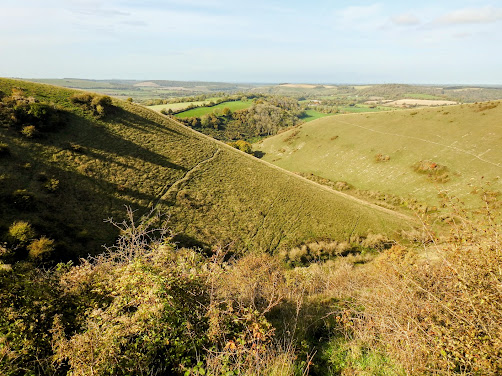Saturday 22nd October 2022.
It was mostly a bright and sunny day as Andy and myself spent most of the morning and early afternoon on Hayling Island. We tried out several areas for anything of note, sure there must be something rare lurking about within the brambles and trees, but to be honest, I think the rarest bird we saw all day was a Razorbill off the harbour entrance at Sandy Point.
Checking Andy’s moth box, the trio of Marveille du Jour, Green-brindled Crescent and Cypress Carpet were still present in his back conservatory, but also present was a Diamond-back Moth that was sitting close to the light bulb and a Blair's Mocha resting on the outside wall. The rest of the moths present were several Light Brown Apple Moths, at least 4 Eudonia angustea, 1 Tachystola acroxantha and finally, a Clepsis Consimlina.
A few flocks of Redwing flew over his house including one flock of at least 40+ birds, but not a great deal else bar a Robin singing its heart out close by. I was thinking of trying out Woolmer Pond and even Butser Hill, where the latter site held up to 5 Ring Ouzels today and lots of winter thrushes over. Andy suggested Sandy Point, after that large number of Razorbills that turned up there recently. So southbound we went.
Parking up by the footpath at Seafarers Walk, we slowly made our way to the harbour entrance. I really fancied my chances of a Yellow-barred Warbler or something rarer, but the best we could notch up was a male Goldcrest flitting through the vegetation. A pair of Jays were making a racket in a small tree and the cause soon flew out, a female Sparrowhawk that promptly flew off northbound.
We made our way to the Lifeboat Station to view the harbour with the scope, but beforehand, we checked out the bushes on the way, but all we could notch up were flyover Meadow Pipits and Skylarks, while the Bushes held a few Great Tits and Robins. I did hear a few Siskins flying over and also a Redpoll, but, as per usual, they were so high up I could not spot them. Andy found a Toadstool which I instantly recognised as a Shaggy Inkcap, my first of the year. A Red Admiral was seen sunning itself on the brambles, our first butterfly of the day and a Syrphus species of Hoverfly landed on the back of Andy’s head!
From the Lifeboat Station, we found one Razorbill swimming on the incoming tide within the harbour entrance, but apart from a few Gulls and the occasional flock of Sanderling, all was quiet. I checked out the small harbour to the north where a good number of Brent Geese were swimming and waders (Dunlin, Grey Plover and Ringed Plover) were resting on the sand bar. Walking slowly back to the car, we came across Becky Ladd (another Lazee Birder). We had a good discussion on the birds seen here of late and also about Andy Johnson’s prolonged stay on the Shetlands. She now has the reign of finding all the rare birds here on Hayling, seeing its local patch, so best of luck young lady.
Our next stop was to the Triangle Field by Sparkes Marina and to be honest, I was really surprised at how close we were to Black Point from here. We could see the waders trying to rest on the sand bar, but Becky was telling us earlier that she was getting so frustrated by people wanting to disturb the waders by walking onto their territory. She also found Northern Wheatear here earlier today. Checking out the harbour to the north, again, there was a good number of Brent Geese on the harbour and at least four Sandwich Terns were seen resting on the posts of buoys. Good numbers of waders were flying around including Dunlin, Grey Plover and Ringed Plover, but also smaller numbers of Sanderling that eventually rested on the sand bar. Back at the Triangle Field (saw my Pied Flycatcher earlier in the year here), the best we could find was a male Kestrel, a Goldcrest and several Goldfinches; but all was quiet. A pair of Speckled Wood butterflies were seen on the brambles and nearby, a few Small White butterflies were flying over the Triangle field. Just a shame nothing unusual was found here during our stay.
After picking up some refreshments, our next stop was Sinah Gravel Pits. Again, there wasn't all that much around, bar at least 6 Chiffchaffs and another Sparrowhawk and so we made our way to our final destination, Northney. By now, the tide was making its way out and we noticed a lot of roosting waders resting on the Salt Marsh including Redshank and Black-tailed Godwit. Good numbers of Brent Geese were present, noticeably a lot of juvenile birds that would indicate a good breeding season for this species. Though there were plenty of the latter, any exciting passerines were virtually non-existent, which was very disappointing. We then got a message on our Whatsapp group that a Yellow-browed Warbler had been found over Gilkicker this morning. By now it was 1pm and I decided to call it a day.































































